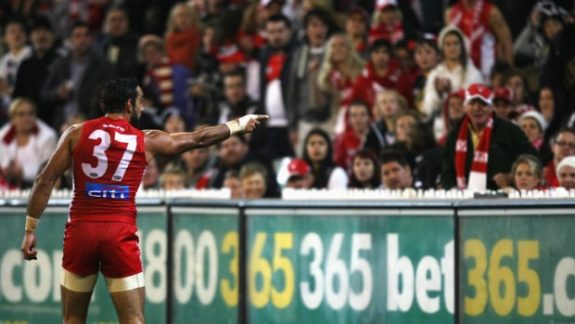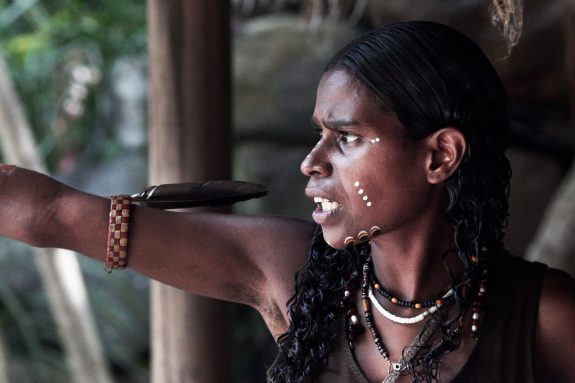Adam Goodes: Free Speech Vs the Moral Authority to Express a View

Our Constitution does not guarantee free speech. It only implies that we have it. That being said, we assume that anyone has a right to express a view. There are some, like Andrew Bolt, who despite us supposedly living in an enlightened society want to enshrine in law the right to hate each other.
What I am getting at here is that having an opinion about booing Adam Goodes has turned into a national pastime. However, all this week, despite the right to free speech, I have been questioning the moral right of some to do so.
Let me make it absolutely clear: I abhor racism with all the intellectual and moral righteousness that has been bequeathed to me by good people. Something unexplainable within me has its way when I am confronted by nefariousness and I speak out.
Adam Goodes is a victim of racism for two reasons. Firstly, because he was named Australian of the Year which obligated him, or gave him license to speak on issues concerning Aboriginality. Secondly, he confronted a young girl who called him an ape. This is the most rancid racist thing you can call any dark skinned person.
He was no longer a champion footballer. He had crossed the line that former Collingwood Football Club President Alan McAlister so ludicrously expressed so many years ago:
“… as long as they behave like white people, well, off the field, everyone will admire and respect them.”
Yes, people have a right to free speech but when there is an absence of truth, a distortion calculated to inflame or just common bigotry I unleash my right to question their motives. When there is a racist element in what they are saying I feel duty bound to question their moral authority to opine. Often it simply displays their hypocrisy so this is where I shall start.
Shane Warne in my view is the greatest bowler to ever roll his arm over. As an individual, throughout his career he has been involved in scandal after scandal displaying pathetic social behaviour. What sort of role model has he been? He even started a charity as a PR exercise at the height of his misconduct. You be the judge. Mine is that his comments show the intellectual depth of a flea. And that’s being kind.
“If the public don’t like a sportsman because of the way they play the game, they boo, if they like them they cheer, nothing to do re racism”.
Last September after a Swans game against Richmond, Warne said he was:
“shocked” Goodes had been named Australian of the Year.
Alan Jones, the sanctimonious self-righteous biased shock jock habitual liar from Sydney accused Goodes of ‘playing the victim’. Jones was once arrested in a London toilet and faced two charges of outrageous public indecency while behaving in an indecent manner, said he was affronted that Goodes would challenge a 13 year old girl. Jones completely ignored the facts of the events that unfolded, overlooked Goodes’ efforts to meet with and counsel the girl, and portrayed the girl as the victim. As for the girl’s obviously inherited morality from the mother, what can one say other than feel pity. I have two grandsons aged 9 and 11 who think the treatment of Goodes is terrible and fully understand that racism is inherently a bad thing. They have needed little instruction on the subject. Should I go on about Jones incitement of the Cronulla riots or his proven history of prostituting his ‘opinions’ and repeatedly disseminating falsehoods as well as having publicly endorsed the idea of murdering our then PM by drowning at sea?
You be the judge.
Andrew Bolt, convicted ‘racist’ and all round appalling paid for controversial opinion journalist – individual who demanded the PM give him more free speech to vilify without constraint also expressed his horror at Goodes confronting the girl:
“Singling out a girl for public humiliation, like that, I thought was wrong and if Adam Goodes said it was wrong, I think he’d be a superstar; all people from either sides would rush to embrace him.”
In doing so he too gave a completely false account of the events that took place. You be the judge. If it were my daughter I would embrace Goodes and say “thank you”. As for the mother’s contribution I can only say she needs a lesson or two in parenthood.
Tony Abbot, a leader with little capacity for it offers lukewarm “we should show more respect” support but when it suits his political needs displays racist overtones against Muslims.
Ross Greenwood, economics commentator, said about his booing of Goodes: “There’s nothing wrong with that, it’s got nothing to do with his race, it’s got nothing to do with me being racist”. He didn’t stop to consider that by contributing to the booing himself, he was legitimizing the real racists.
Sam Newman, the resident ageing buffoon and perpetual aficionado of crassness on the Footy Show; the man who bared his genitals on television and who has affronted many with his sexism and disgusting behavior. The man who painted his face black after Nicky Winmar didn’t appear on the show in 1999 opined that “People aren’t booing you [Goodes] because you’re Aboriginal, they’re booing you because you’re acting like a jerk”. (Only he would know).
He went on to state that Goodes’ celebration only served to provoke fans and should have been reprimanded by the AFL. Newman further said:
“As Australian of the year, you should know that- you should be trying to unite people instead of trying to divide them”. (Isn’t that what he has been doing by speaking about the problems facing Indigenous people?)
You be the judge but for me Newman and other white men like him who have made fortunes out of thoughtlessness have not the remotest capacity to understand the emotional torment that racial abuse might incur. He is one of those many men who have never really grown up and his antics prove it.
Jason Ackermanis, former champion and perennial bad boy of the Brisbane Lions parroted the remarks of Alan Jones and in doing so showed little empathy or understanding of the broader picture. He said that Goodes was “playing the victim”. Something that Akermanis made a career of doing. In 2010 he said that gay footy players should “stay in the closet”. In 2005 Akermanis sparked racial controversy when he used his radio program (the Aker and Macca Show) on Brisbane’s 98.9 FM to describe his employers as “monkeys”. It was an Aboriginal community owned station run by the legendary Tiga.
You be the judge but have any of these people made the slightest attempt to comprehend emotionally what it must be like to be being booed by thousands of people every time you go near the ball and not comprehend why they are doing it or conversely believe they are doing it because of the colour of your skin? I can feel it as I write but I bet my feelings are unworthy of his. Does he hear in the raised hiss of intolerance the eco of the wounds from the racism he experienced as a child? Or does he hear in the booing crescendo a symphony of humiliation from the white bastards he seeks to befriend.
The problem here is that the people aforementioned have a common thread. They all are paid huge amounts to be controversial. They are all media tarts with dubious moral standards that brings into question their moral authority to make judgement on their fellow humans. Rather they are insisting on the right to tell them how to behave. And do so while theirs goes unquestioned. What two-faced hypocrisy it is.
These people aside the media generally speaking have made some worthwhile contributions to the issue of race in Australia.
As much as it offends my pride of country I have to admit that the tide of racism flows down the streets of our cities, and through the veins of our culture. And it waters the fields of our play.
As a citizen of the state of Queensland said:
“Let me get this straight … If Adam Goodes stands up against racism that makes him a racist? And if someone makes racial slurs towards him and he doesn’t just “cop it” like all the rednecks want him to, then he’s a sook and a troublemaker?”
These are my thoughts. You be the judge.
Like what we do at The AIMN?
You’ll like it even more knowing that your donation will help us to keep up the good fight.
Chuck in a few bucks and see just how far it goes!
Your contribution to help with the running costs of this site will be gratefully accepted.
You can donate through PayPal or credit card via the button below, or donate via bank transfer: BSB: 062500; A/c no: 10495969










